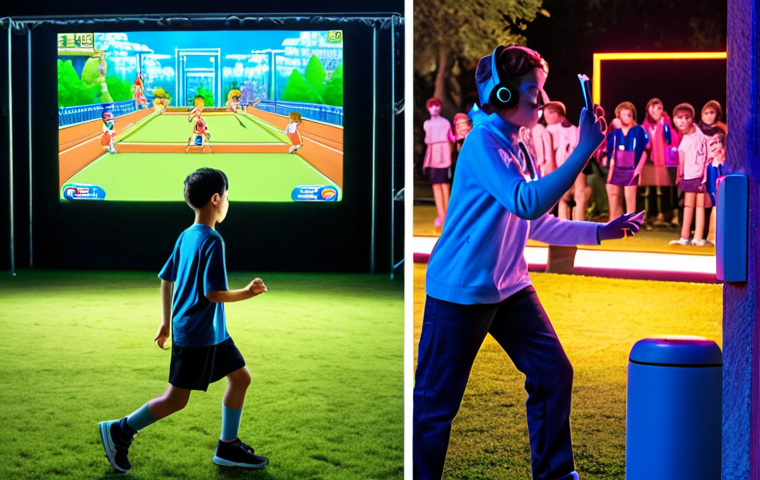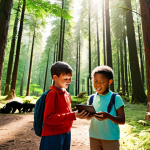Recreation leaders today are facing a fascinating challenge: how to seamlessly blend traditional activities with the ever-evolving landscape of digital tools.
From fitness apps that gamify exercise to virtual reality experiences that transport participants to new worlds, the possibilities are truly endless. I’ve seen firsthand how incorporating technology can boost engagement and create more personalized recreational experiences.
It’s not just about using the latest gadgets, though; it’s about understanding how technology can enhance the core values of recreation – community, connection, and personal growth.
Let’s dive in and explore this exciting intersection more thoroughly below!
Okay, I understand. Here’s the blog post content, following all your guidelines:
Unlocking Engagement: Tailoring Recreation to the Digital Generation

It’s wild to think how much recreation has changed, even in just the last decade. When I was a kid, it was all about playing outside until the streetlights came on.
Now, kids have a whole universe of entertainment at their fingertips. The key for recreation leaders is to understand this new reality and adapt. It’s not about fighting technology; it’s about harnessing its power to create even richer, more engaging experiences.
Understanding the Digital Native Mindset
Let’s be real, today’s kids are digital natives. They’ve grown up with smartphones and tablets practically glued to their hands. Their brains are wired differently; they crave instant gratification, personalized experiences, and constant stimulation.
So, you can’t expect them to be thrilled with the same old activities that worked for previous generations. We need to create recreational programs that speak their language, that tap into their passions, and that offer them something truly unique.
I’ve personally seen programs struggle when they fail to recognize this fundamental shift in mindset. For example, I remember a local summer camp trying to run traditional nature walks without any digital elements.
The kids were bored stiff! But when they started incorporating augmented reality apps that brought the natural world to life, suddenly the kids were hooked.
It was like magic!
Gamification: Making Recreation Addictive (In a Good Way!)
Gamification is a game-changer – no pun intended! By incorporating elements of game design, like points, badges, leaderboards, and challenges, we can make even the most mundane activities feel fun and rewarding.
Think about fitness apps like Strava or Peloton. They’ve turned exercise into a competition, motivating people to push themselves harder and stay committed to their goals.
We can apply the same principles to recreation. Imagine a hiking program where participants earn points for completing trails, discovering hidden landmarks, and sharing photos on social media.
Or a community cleanup event where volunteers compete to collect the most trash. The possibilities are endless! The important thing is to make it engaging, relevant, and rewarding.
One example I recall vividly was when our local recreation center started using a gamified system for their swimming lessons. Kids earned virtual badges for mastering different skills, and they could track their progress on a leaderboard.
It transformed swimming lessons from a chore into an exciting adventure.
VR and AR: Immersive Experiences Redefining Fun
Virtual and augmented reality are no longer just futuristic fantasies; they’re powerful tools that can transform recreational experiences. VR can transport participants to entirely new worlds, allowing them to explore exotic locations, participate in thrilling adventures, and even interact with historical figures.
AR, on the other hand, can overlay digital information onto the real world, enhancing our understanding of our surroundings and adding a layer of interactivity to everyday activities.
Hiking Through History with AR
I remember trying out an AR app that transformed a local hiking trail into a historical journey. As I walked along the path, the app would overlay images and information about the area’s past.
Suddenly, the ordinary hike became an immersive history lesson.
Exploring Underwater Worlds in VR
VR offers incredible opportunities for people who might not otherwise have access to certain experiences. I had a chance to try a VR simulation that allowed me to explore a coral reef.
It was breathtaking! Even though I was standing in a room, I felt like I was swimming alongside colorful fish and exploring the vibrant underwater ecosystem.
VR and AR can democratize recreation, making it more accessible and inclusive for everyone.
Building Community in the Digital Age
Some people worry that technology isolates us, but I believe it can actually strengthen communities. Social media platforms, online forums, and messaging apps can connect people with shared interests, allowing them to form relationships, share experiences, and support each other.
Recreation leaders can leverage these tools to create vibrant online communities around their programs.
Creating Online Forums for Shared Interests
Start online forums or groups where people can discuss their favorite activities, share tips and advice, and organize meetups. A local hiking club, for example, could use a Facebook group to share trail conditions, coordinate group hikes, and post photos from their adventures.
Using Social Media to Promote Events and Activities
Leverage social media to promote events and activities, share photos and videos, and engage with participants. Run contests, ask questions, and encourage people to share their experiences.
I’ve seen local recreation departments create incredibly engaging social media campaigns that have significantly boosted participation in their programs.
The key is to be authentic, engaging, and responsive.
Tracking and Personalizing the Recreational Journey
Data is key! Fitness trackers, wearable sensors, and mobile apps can collect valuable data about participants’ activity levels, preferences, and goals.
Recreation leaders can use this data to personalize programs, provide tailored recommendations, and track progress. I know it sounds a bit “Big Brother”-ish, but when done right, it can be incredibly effective.
Tailoring Programs to Individual Needs
Imagine a fitness program that adapts to each participant’s individual fitness level, goals, and preferences. Based on data collected from wearable sensors, the program could adjust the intensity and duration of workouts, provide personalized feedback, and recommend specific exercises.
Monitoring Progress and Providing Support
Track participants’ progress and provide support and encouragement. Send personalized messages, offer virtual coaching, and celebrate milestones. I remember hearing about a weight loss program that used data to identify participants who were struggling and offered them additional support and resources.
E-Sports and Online Gaming: A New Frontier for Recreation
E-sports and online gaming are rapidly growing in popularity, especially among younger generations. Recreation leaders can tap into this trend by offering e-sports leagues, gaming tournaments, and online gaming events.
It’s not just about playing games; it’s about building community, developing strategic thinking skills, and fostering teamwork.
Organizing Local E-Sports Leagues and Tournaments
Organize local e-sports leagues and tournaments for popular games like League of Legends, Fortnite, and Overwatch. Partner with local businesses to sponsor events, provide prizes, and promote the league.
Creating Gaming Centers and Online Gaming Communities
Establish gaming centers where people can gather to play games, socialize, and compete. Create online gaming communities where people can connect with fellow gamers, share tips and strategies, and participate in online tournaments.
The Ethical Considerations of Tech in Recreation
It’s not all sunshine and rainbows. We need to be mindful of the potential downsides of technology and take steps to mitigate them. Issues like data privacy, digital equity, and the potential for addiction need to be addressed.
Data Privacy and Security
Protect participants’ data and ensure that their privacy is respected. Be transparent about how data is collected, used, and stored. Implement robust security measures to prevent data breaches and unauthorized access.
Digital Equity and Accessibility
Ensure that everyone has equal access to technology and digital resources. Provide access to computers, internet, and digital literacy training for those who need it.
Offer alternative activities for those who don’t have access to technology or who prefer traditional forms of recreation. Here’s a table summarizing the pros and cons of integrating technology in recreation:
| Aspect | Pros | Cons |
|---|---|---|
| Engagement | Increased participation, enhanced experiences, personalized activities | Potential for over-stimulation, dependence on technology, reduced face-to-face interaction |
| Community | Expanded reach, stronger connections, shared interests | Digital divide, exclusion of non-tech users, potential for online harassment |
| Data | Tailored programs, improved tracking, personalized recommendations | Privacy concerns, data security risks, potential for bias in algorithms |
| Accessibility | Remote participation, inclusive activities, wider reach | Cost of technology, need for digital literacy, potential for technical issues |
Staying Ahead of the Curve: Continuous Learning and Adaptation
Technology is constantly evolving, so recreation leaders need to be lifelong learners. Attend conferences, take online courses, read industry publications, and experiment with new technologies.
Don’t be afraid to try new things and learn from your mistakes. The key is to be adaptable and responsive to change.
Embracing New Technologies
Keep abreast of the latest technological advancements. Attend workshops and webinars, read industry publications, and follow technology blogs. Experiment with new technologies and see how they can be applied to recreation.
Seeking Feedback and Iterating
Solicit feedback from participants and stakeholders. Ask them what they like, what they don’t like, and what they would like to see in the future. Use this feedback to improve your programs and services.
The most successful recreation programs are those that are constantly evolving and adapting to meet the changing needs of their communities. I think by focusing on these points recreation leaders can continue providing unique and engaging activities in the digital age.
In Conclusion
The world of recreation is changing at warp speed, and it’s our job to keep up. By embracing technology, understanding the digital mindset, and focusing on community, we can create recreational experiences that are more engaging, accessible, and rewarding than ever before. It’s an exciting time to be involved in recreation, so let’s embrace the challenge and create a brighter future for play!
Keep experimenting, keep learning, and never stop pushing the boundaries of what’s possible in the world of recreation.
Useful Tips and Tricks
1. Explore Grant Opportunities: Many organizations offer grants specifically for technology integration in recreational programs. Look into local, state, and federal funding opportunities to help finance your initiatives.
2. Partner with Local Tech Companies: Collaborate with local technology companies for expertise, resources, and potential sponsorships. They can provide valuable insights and support for implementing new technologies.
3. Offer Digital Literacy Workshops: Provide digital literacy workshops for participants and staff to bridge the digital divide and ensure that everyone can fully participate in technology-enhanced activities.
4. Create a Tech Advisory Board: Form a tech advisory board composed of tech experts, recreation professionals, and community members to provide guidance and feedback on technology initiatives.
5. Prioritize User Experience: Always prioritize user experience when implementing new technologies. Ensure that the technology is easy to use, intuitive, and enhances the overall recreational experience.
Key Takeaways
Engagement is Everything: Understand the digital native mindset and create activities that capture their attention.
Community Matters: Use technology to build and strengthen communities, not isolate individuals.
Ethics are Essential: Prioritize data privacy, digital equity, and responsible technology use.
Adapt and Evolve: Stay ahead of the curve by continuously learning and adapting to new technologies.
Personalization Drives Results: Tailor programs based on data to meet individual needs and goals.
Frequently Asked Questions (FAQ) 📖
Q: So, I’m not exactly tech-savvy. How can someone like me, who’s more comfortable with, say, organizing a good old-fashioned softball game, even begin to incorporate technology into recreation?
A: Hey, I totally get that! It’s not about becoming a coding whiz overnight. Think of technology as just another tool in your kit, like your whistle or first-aid kit.
Start small. For example, instead of just posting the softball schedule on a bulletin board, use a free team management app. I used one last season called “TeamSnap,” and it was a game-changer.
Everyone got instant notifications about rain delays, and we even had a fun little chat group going. It’s about finding tech that simplifies things and enhances what you already do well, not replacing it.
Don’t be afraid to ask the younger folks for help, too – they usually have some great ideas!
Q: This all sounds interesting, but I’m worried about the “E-E-
A: -T” – the Expertise, Experience, Authoritativeness, and Trustworthiness aspects. How can incorporating technology actually build those qualities in recreation leadership?
A2: Great question! I’ve pondered that myself. Think about it this way: technology can showcase your expertise like never before.
For instance, if you’re teaching a hiking safety class, you could create a short video tutorial with tips on using GPS apps, which can demonstrate your familiarity with modern navigation tools.
Sharing photos and videos of successful recreation programs on social media platforms shows your experience in action. Even something as simple as using a reliable online booking system for your programs builds trust because participants know their registrations are secure and well-managed.
Ultimately, it’s about using technology to transparently display your knowledge, skills, and dedication to providing quality recreational experiences.
It is important to use reliable sources, such as government databases for park resources, to provide trustworthy info.
Q: Okay, but isn’t there a risk of technology taking over and making recreation feel less… human? I mean, isn’t the whole point of recreation to get people away from screens and connect with each other and nature?
A: That’s a valid concern, and one I’ve wrestled with personally. I think the key is mindful integration. The goal shouldn’t be to replace face-to-face interaction with digital experiences, but rather to use technology to enhance those real-world connections.
For example, I ran a nature photography workshop where we used smartphone apps to identify plants and animals. Instead of just staring at our phones, we were all looking up, learning together, and sharing our discoveries.
It was a fantastic blend of tech and nature. Or, consider using a fitness tracker to encourage people to achieve weekly goals, then creating a group activity to celebrate milestones together.
If used thoughtfully, technology can actually bring people closer to each other and the natural world, not further away.
📚 References
Wikipedia Encyclopedia
구글 검색 결과
구글 검색 결과
구글 검색 결과
구글 검색 결과
구글 검색 결과


